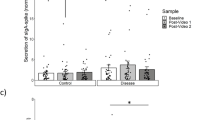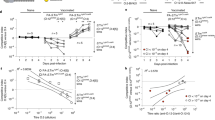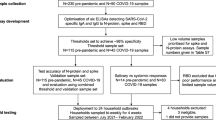Abstract
To define the relationship between salivary SIgA antibodies and commensal oral bacteria, we examined the reactivity of SIgA antibodies from the saliva of four infants with their own colonizing Streptococcus mitis biovar 1 (S. mitis bv 1) clones (ribotypes). Immunoblot analysis was used to examine reactivity of these antibodies with persistent ribotypes isolated from the mouths of the infants over the first year postpartum. Results showed that the pattern of SIgA antibody reactivity with the majority of clones increased in complexity after colonization but that most additional bands were common to other clones, indicating that they represented shared antigens. However, unique bands were identified in 75% of the selected persistent clones. We hypothesized that if strain-specific SIgA antibody was induced in response to colonization of a particular clone and contributed to its elimination from the mouth, then the appearance of unique bands would immediately precede the disappearance of the strain. Seventy-three percent of all unique bands identified in the study fulfilled this criterion. Because the mouth is an open, dynamic environment and multiple factors are believed to play a role in the immune response at mucosal surfaces, it may not be possible to conclusively define the relationship between SIgA antibody and commensal bacteria. However, our data provide evidence that SIgA antibody, reactive with unique antigens of their own colonizing strains, is produced in infants and may point to a role of this antibody in regulating colonization by S. mitis bv 1.
Similar content being viewed by others
Log in or create a free account to read this content
Gain free access to this article, as well as selected content from this journal and more on nature.com
or
References
Bowden GH, Hamilton IR . 1998. Survival of oral bacteria. Crit Rev Oral Biol Med 9: 54–85.
Brandtzaeg P, Fjellanger I, Gjeruldsen ST . 1968. Adsorption of immunoglobulin A onto oral bacteria in vivo. J Bacteriol 96: 242–249.
Cole MF, Bryan S, Evans MK, Pearce CL, Sheridan MJ, Sura PA et al. 1998. Humoral immunity to commensal oral bacteria in human infants: salivary antibodies reactive with Actinomyces naeslundii genospecies 1 and 2 during colonization. Infect Immun 66: 4283–4289.
Cole MF, Bryan S, Evans MK, Pearce CL, Sheridan MJ, Sura PA et al. 1999. Humoral immunity to commensal oral bacteria in human infants: salivary secretory immunoglobulin A antibodies reactive with Streptococcus mitis biovar 1, Streptococus oralis, Streptococcus mutans, and Enterococcus faecalis during the first two years of life. Infect Immun 67: 1878–1886.
Cole MF, Evans MK, Kirchherr JL, Sheridan MJ, Bowden GH . 2004. Study of humoral immunity to commensal oral bacteria in human infants demonstrates the presence of secretory immunoglobulin A antibodies reactive with Actinomyces naeslundii genospecies 1 and 2 ribotypes. Clin Diagn Lab Immunol 11: 473–482.
Fitzsimmons SP, Evans M, Pearce C, Sheridan MJ, Wientzen R, Bowden G et al. 1996. Clonal diversity of Streptococcus mitis biovar 1 isolates from the oral cavity of human neonates. Clin Diagn Lab immunol 3: 517–522.
Fitzsimmons SP, Evans MK, Sheridan MJ, Wientzen R, Cole MF . 1994. Immunoglobulin A subclasses in infant′s saliva and in saliva and milk from their mothers. J Pediatr 124: 566–573.
Gregory RL, Kindle JC, Hobbs LC, Filler SJ, Malmstrom HS . 1990. Function of anti-Streptococcus mutans antibodies: inhibition of virulence factors and enzyme neutralization. Oral Microbiol Immunol 5: 181–188.
Hohwy J, Kilian M . 1995. Clonal diversity of the Streptococcus mitis population in the human oral cavity and pharynx. Oral Microbiol Immunol 10: 19–25.
Hohwy J, Reinholdt J, Kilian M . 2001. Population dynamics of Streptococcus mitis in its natural habitat. Infect Immun 69: 6055–6063.
Kirchherr JL, Bowden GH, Richmond DA, Sheridan MJ, Wirth KA, Cole MF . 2005. Clonal diversity and turnover of Streptococcus mitis bv. 1 on shedding and nonshedding oral surfaces of human infants during the first year of life. Clin Diagn Lab Immunol 12: 1184–1190.
Mestecky J, McGhee JR . 1987. Immunoglobulin A (IgA): molecular and cellular interactions involved in IgA biosynthesis and immune response. Adv Immunol 40: 153–245.
Pearce C, Bowden GH, Evans M, Fitzsimmons SP, Johnson J, Sheridan MJ et al. (1995). Identification of pioneer viridans streptococci in the oral cavity of human neonates. J Med Microbiol 42: 67–72.
Quan CP, Berneman A, Pires R, Avrameas S, Bouvet J-P . 1997. Natural polyreactive secretory immunoglobulin A autoantibodies as a possible barrier to infection in humans. Infect Immun 65: 3997–4004.
Smith DJ, King WF, Taubman MA . 1990. Salivary IgA antibody to oral streptococcal antigens in predentate infants. Oral Microbiol Immunol 5: 57–62.
Smith DJ, Taubman MA, Ebersole JL . 1985. Salivary IgA antibody to glucosyl-transferase in man. Clin Exp Immunol 61: 416–424.
Widerstrom L, Bratthall D, Hamberg K . 1992. Immunoglobulin A antibody activity to mutans streptococci in parotid, submandibular and whole saliva. Oral Microbiol Immunol 7: 326–331.
Acknowledgements
This work was supported by Public Health Service Grant DE08171 from the National Institute of Dental and Craniofacial Research.
Author information
Authors and Affiliations
Corresponding author
Rights and permissions
About this article
Cite this article
Wirth, K., Bowden, G., Kirchherr, J. et al. Humoral immunity to commensal oral bacteria in human infants: evidence that Streptococcus mitis biovar 1 colonization induces strain-specific salivary immunoglobulin A antibodies. ISME J 2, 728–738 (2008). https://doi.org/10.1038/ismej.2008.26
Received:
Revised:
Accepted:
Published:
Issue date:
DOI: https://doi.org/10.1038/ismej.2008.26



